How to use Timeshift to backup and restore a Linux system
As a highly customizable operating system and heavily dependent on CLI interactions, Linux is prone to system failures due to incorrect system commands or operations. So if you use Linux on your main computer, you might run into problems often.
Luckily, there are system restore tools that take snapshots of your files and settings, which you can restore on your system to bring it back to a previous operating point in the event of any manipulations. Your actions render the system unusable.
Timeshift is one such tool for Linux. And in this tutorial, Tipsmake will guide you through using Timeshift on a Linux computer.
How to Install Timeshift on Linux
Timeshift comes pre-installed on some Linux distributions. With other distributions, you need to install them manually.
1. On Ubuntu and its derivatives
If you are using Ubuntu and its derivatives like Linux Mint, elementary OS, etc…, you most likely have Timeshift pre-installed on it. And so you can start using it right away.
However, in case it's not there, you can install Timeshift on Ubuntu by running the following commands in the terminal:
sudo add-apt-repository -y ppa:teejee2008/timeshift sudo apt-get update sudo apt-get install timeshift
Alternatively, you can go to the Software Manager on your distro and install Timeshift from there.
2. On Fedora, CentOS and RHEL
Timeshift only supports BTRFS snapshots in Fedora. To get it use:
sudo dnf install timeshift
3. On Arch Linux and Manjaro
Finally, on Arch Linux, Manjaro and similar distros, you can install Timeshift with:
yay -S timeshift
Run and Initialize Timeshift
After you have installed Timeshift, open the Applications menu, search for Timeshift and launch it. It will ask you to enter the user password for authentication. Enter the password and tap Authenticate.
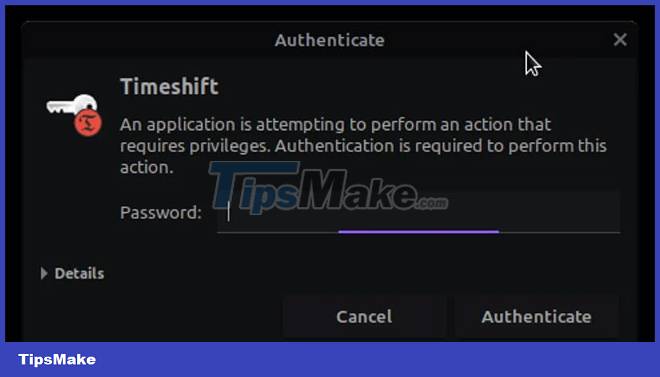
Now, if this is your first time running Timeshift on your computer, you will be greeted with the Setup Wizard. Here, you need to set options for a few different Timeshift settings.
First, you will have to choose between two types of snapshots Rsync and Btrfs.
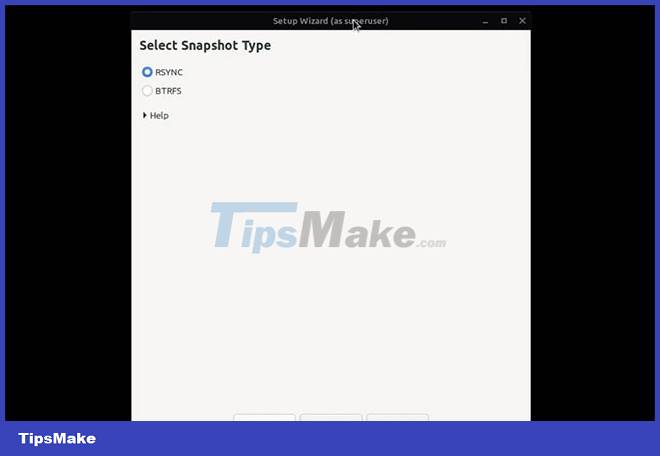
The Rsync option creates snapshots using rsync and hard links. Essentially, an Rsync snapshot contains only files and directories that have been changed or modified - the rest of the files (which are unchanged) are not backed up in the snapshot. Therefore, it takes up less disk space. On the other hand, Btrfs mode is ideal for users using one of the Linux distributions that use the btrfs file system.
After selecting a suitable snapshot type, click Next.
Chờ một vài giây trong khi Timeshift ước tính kích thước hệ thống của bạn. Ngay sau khi nó kết thúc, hãy chọn một vị trí trên hệ thống nơi bạn muốn lưu snapshot Timeshift.
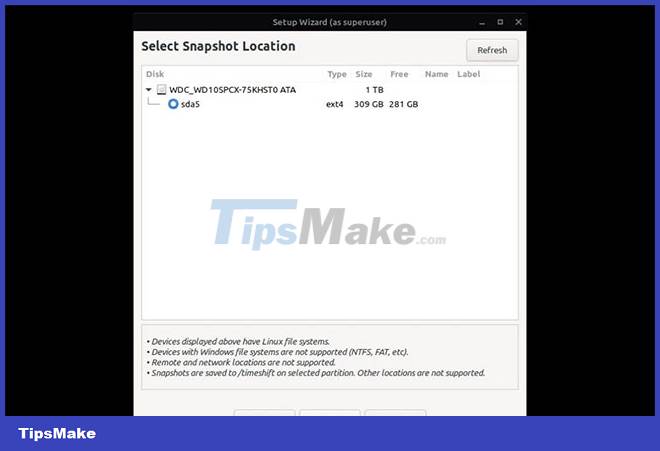
Bài viết khuyên bạn nên thực hiện việc này trên ổ cứng gắn ngoài hoặc ổ cứng HDD/SSD ngoài, vì làm như vậy có thể giúp bạn an toàn trong những trường hợp không thể khởi động vào hệ thống. Nhấn Next để tiếp tục.
Tùy thuộc vào tần suất bạn sửa đổi các phần tử hệ thống của mình, bước tiếp theo là chọn tần suất thực hiện snapshot. Thao tác này sẽ tự động sao lưu tất cả các file và cài đặt hệ thống của bạn vào khoảng thời gian bạn đã đặt mà không cần sự can thiệp của bạn.
Đánh dấu vào hộp kiểm bên cạnh một cấp trong Select Snapshot Levels và nhấn Next.
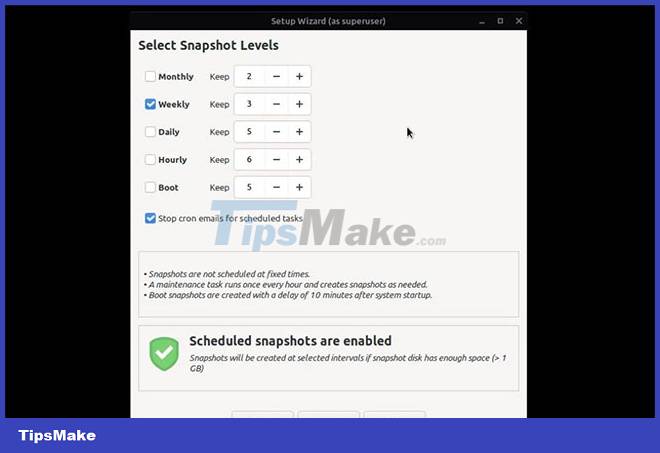
Finally, Timeshift asks if you want to back up your home directory to the snapshot. Select an option here as appropriate and click Next.
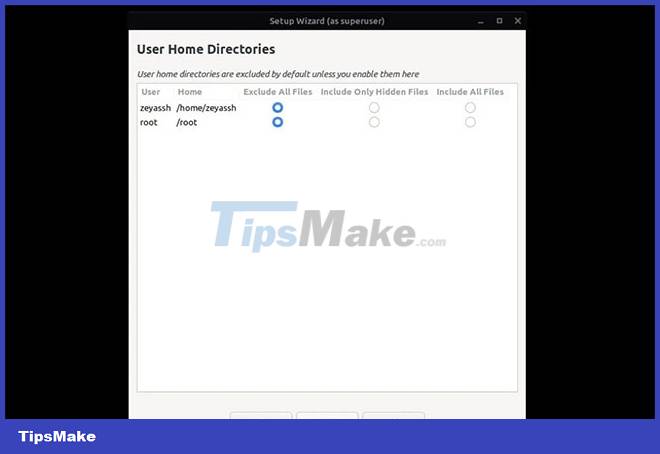
Click Finish to complete the setup.
How to use Timeshift on Linux
After successfully setting up Timeshift on your machine, you will be taken to the main window.
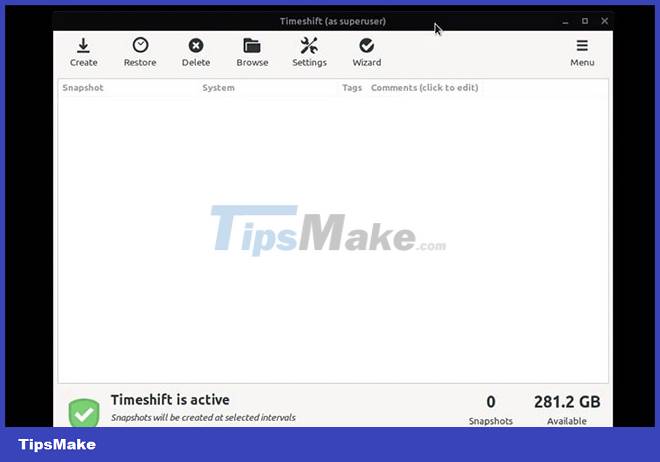
You can perform all Timeshift operations in this window, as shown in the sections below:
1. Create a snapshot using Timeshift
Press the Create button on the main Timeshift window and Timeshift will start creating a snapshot using your set options.
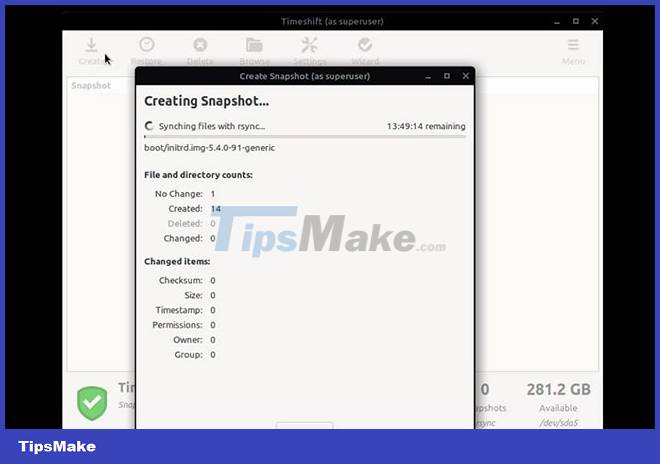
Wait for the process to complete.
Since this is your first snapshot, it may take a significant amount of time compared to the snapshots you will take afterwards. Once the snapshot is ready, it will appear in the main window.
2. Restore snapshot
You can restore the snapshot in two cases: When your system is up and when you are unable to boot into your system. In the first case, press the Restore button on the main Timeshift window and it will open a window where you need to select the snapshot you want to restore.

In addition, it will also ask you to select the destination partition to which the snapshot needs to be restored. Select it and click Next.
Timeshift will now compare the current system state with the state in the snapshot. Depending on the size of your snapshot, this can also take time.
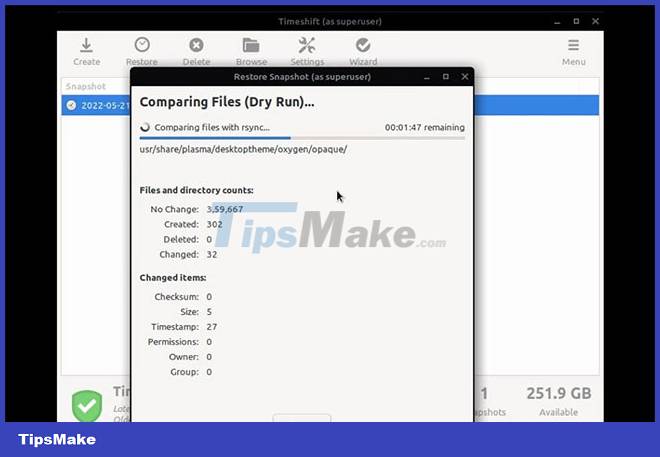
Once done, you will see a list of all the files and folders that need to be restored and deleted. Go through this list to verify the changes, and no important files or settings were modified in the process.
After you are satisfied with the changes, click Next to confirm. Again, click Next in the following warning screen to confirm the snapshot restore.

Wait a moment and Timeshift will restore your snapshot.
In case you are unable to boot into the system, you can try to boot into it using a live USB and then use Timeshift to restore it to its previous working state and fix any system components, settings or files. system is damaged or misconfigured.
3. Delete snapshot
If you happen to store a lot of media and software on your local machine and for some reason you are also saving the snapshot on the same drive, then you may want to delete the old snapshot at some point to resolve the issue. free up disk space.
To do this, click the Delete tab on the main Timeshift window. Then, select the snapshot you want to delete and press the Delete button.
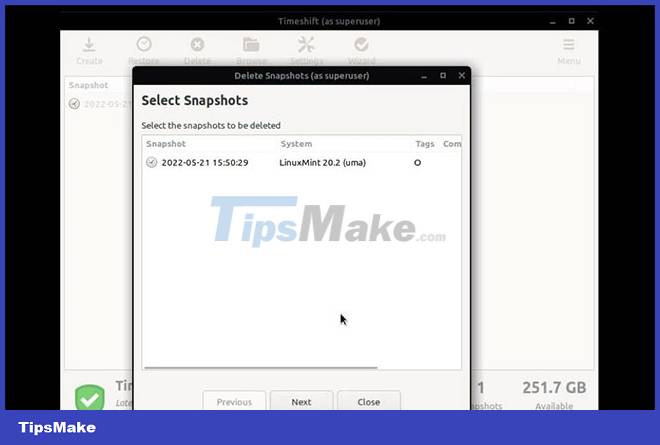
The system restore utility is a must-have application on Linux computers, especially if you love to customize your system and need to adjust its various configurations and system files quite often.
Therefore, it is also essential to ensure that the tool automatically takes the appropriate snapshots. Hope this guide helps you get started with Timeshift. You can use it to set up automatic snapshots, so that when you need to restore the system, you can do it quite easily.
Similarly, another great Linux system backup and restore utility is dd, which backs up your entire system, including everything from system settings to all documents, files, and even application.
You should read it
- 5 best open source backup utilities for Linux
- Compare the most popular Linux distributions today
- Backup Linux, Mac or Windows using fwbackups
- Complete how to use all backup and restore tools on Windows 10
- How to use Backup and Restore on Windows 7?
- 14 interesting Linux commands in Terminal
- What to back up on a Linux Home Server system?
- 10 reasons to switch to Linux right in 2012
May be interested
- Instructions on how to use System Restore on Windows
 system restore is a tool available on the windows operating system, enabling users to restore windows state at a certain time, created by the user or by a specific computer.
system restore is a tool available on the windows operating system, enabling users to restore windows state at a certain time, created by the user or by a specific computer. - How to backup SMS messages with SMS Backup and Restore
 backing up messages on the cloud application will help us find what we need, which can save memory on android devices.
backing up messages on the cloud application will help us find what we need, which can save memory on android devices. - Top 5 software to Backup (Restore) and Restore (Restore) the best Computer Driver
 in the process of using the computer will be very difficult to avoid errors, so backing up the driver is necessary in case of a risk. the following article of tipsmake.com will introduce to you the 5 best software backup and restore software for your computer today, please refer.
in the process of using the computer will be very difficult to avoid errors, so backing up the driver is necessary in case of a risk. the following article of tipsmake.com will introduce to you the 5 best software backup and restore software for your computer today, please refer. - Instructions to Backup and Restore Windows 10
 how to backup and restore windows 10. if you are a smart and professional computer user, then in the process of using the computer we should create regular backups (backup). pierce and use them to restore when needed.
how to backup and restore windows 10. if you are a smart and professional computer user, then in the process of using the computer we should create regular backups (backup). pierce and use them to restore when needed. - How to back up automatically on Windows 10
 to automatically backup windows 10 computers, we can immediately use the windows backup feature available on the system to back up data.
to automatically backup windows 10 computers, we can immediately use the windows backup feature available on the system to back up data. - Backup and restore Android phone with Titanium Backup
 if you encounter a problem with backing up your android device, including everything from system apps to data, titanium backup is the most convenient and appropriate tool. in the following article, we will introduce you some key features and usage of this utility ...
if you encounter a problem with backing up your android device, including everything from system apps to data, titanium backup is the most convenient and appropriate tool. in the following article, we will introduce you some key features and usage of this utility ... - Instructions to restore your computer using an Android device
 your computer's operating system is corrupted and the only way to recover is to use an iso file flashed into a usb stick. but if you don't have a backup computer to create an installation media, you can use android to restore your computer. this article will show you how to restore your computer using an android phone or tablet.
your computer's operating system is corrupted and the only way to recover is to use an iso file flashed into a usb stick. but if you don't have a backup computer to create an installation media, you can use android to restore your computer. this article will show you how to restore your computer using an android phone or tablet. - Restore and Backup data on Mac using Time Machine
 backing up your system regularly is essential. on mac, the built-in time machine tool will help users to backup or restore data faster.
backing up your system regularly is essential. on mac, the built-in time machine tool will help users to backup or restore data faster. - How to use System Restore in Windows: Turn off, turn on, create, restore System Restore
 system restore is a windows utility that allows users to restore the status of a window at a certain time. the time of recovery can be set by the computer or by the user. software, data from the time of restore are deleted.
system restore is a windows utility that allows users to restore the status of a window at a certain time. the time of recovery can be set by the computer or by the user. software, data from the time of restore are deleted. - How to backup Raspberry Pi
 since the raspberry pi uses a microsd card for storage, creating a raspberry backup is pretty easy on any platform. here's how to back up a raspberry pi sd card on windows as well as how to restore the card from that backup.
since the raspberry pi uses a microsd card for storage, creating a raspberry backup is pretty easy on any platform. here's how to back up a raspberry pi sd card on windows as well as how to restore the card from that backup.










 What's new in Linux Kernel 5.18?
What's new in Linux Kernel 5.18? 5 ways to open calculator apps on Debian
5 ways to open calculator apps on Debian How to Create Daemon on Linux
How to Create Daemon on Linux How to Connect iPhone to Linux PC Using KDE Connect
How to Connect iPhone to Linux PC Using KDE Connect 5 things to do after upgrading to Ubuntu 22.04 LTS
5 things to do after upgrading to Ubuntu 22.04 LTS How to recover deleted files on Linux
How to recover deleted files on Linux